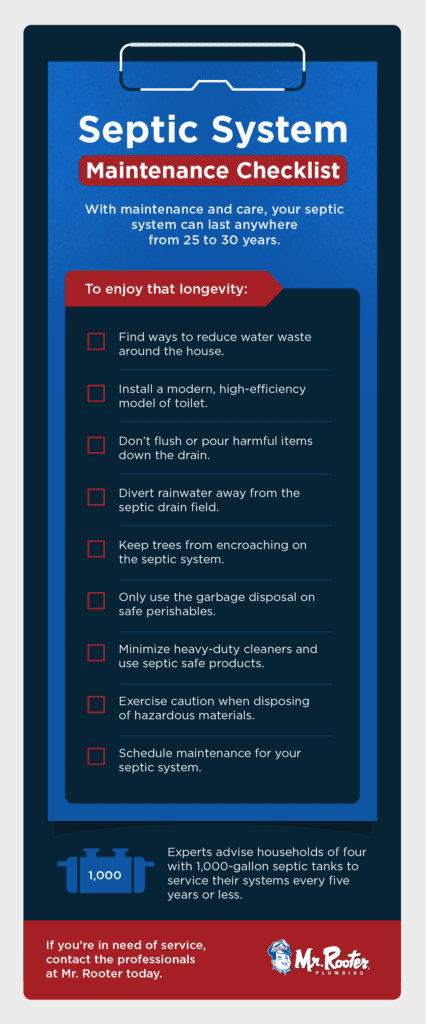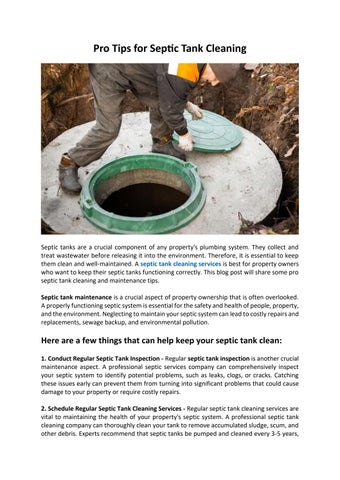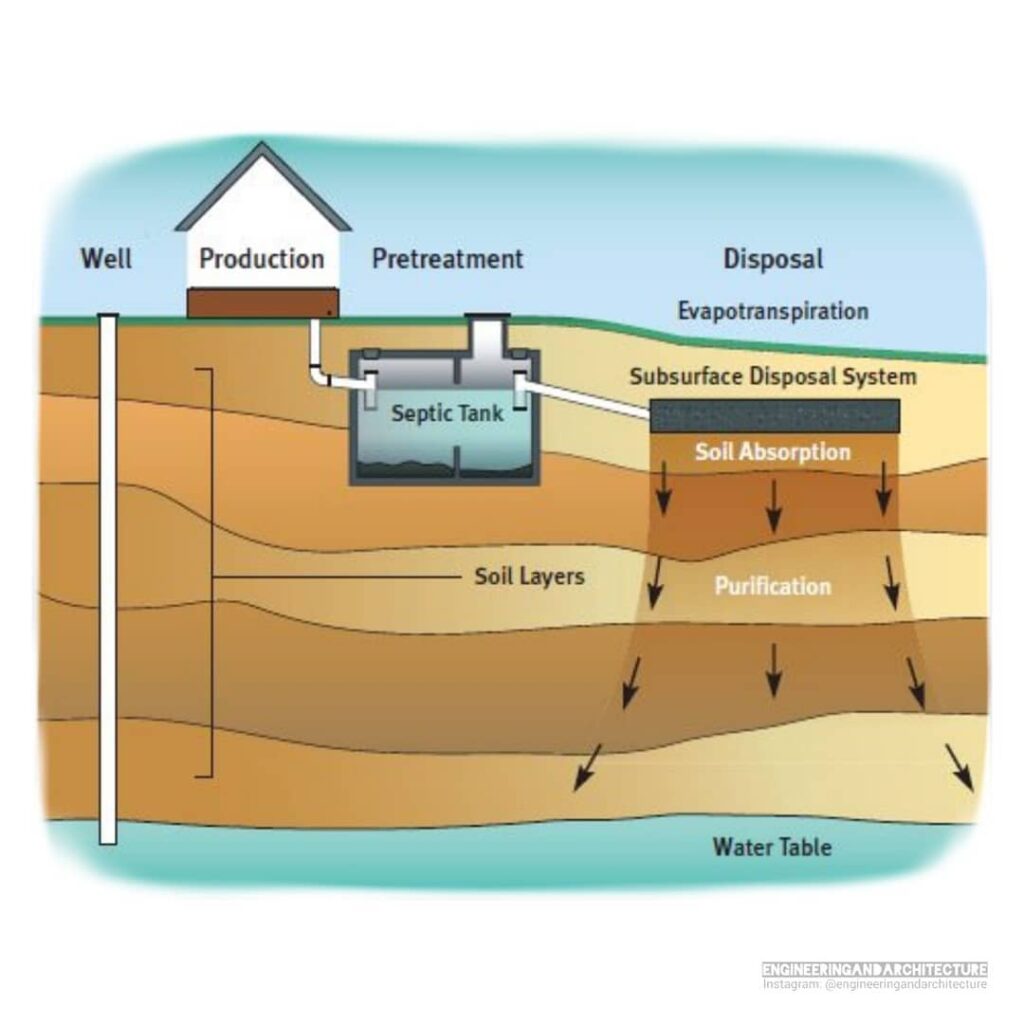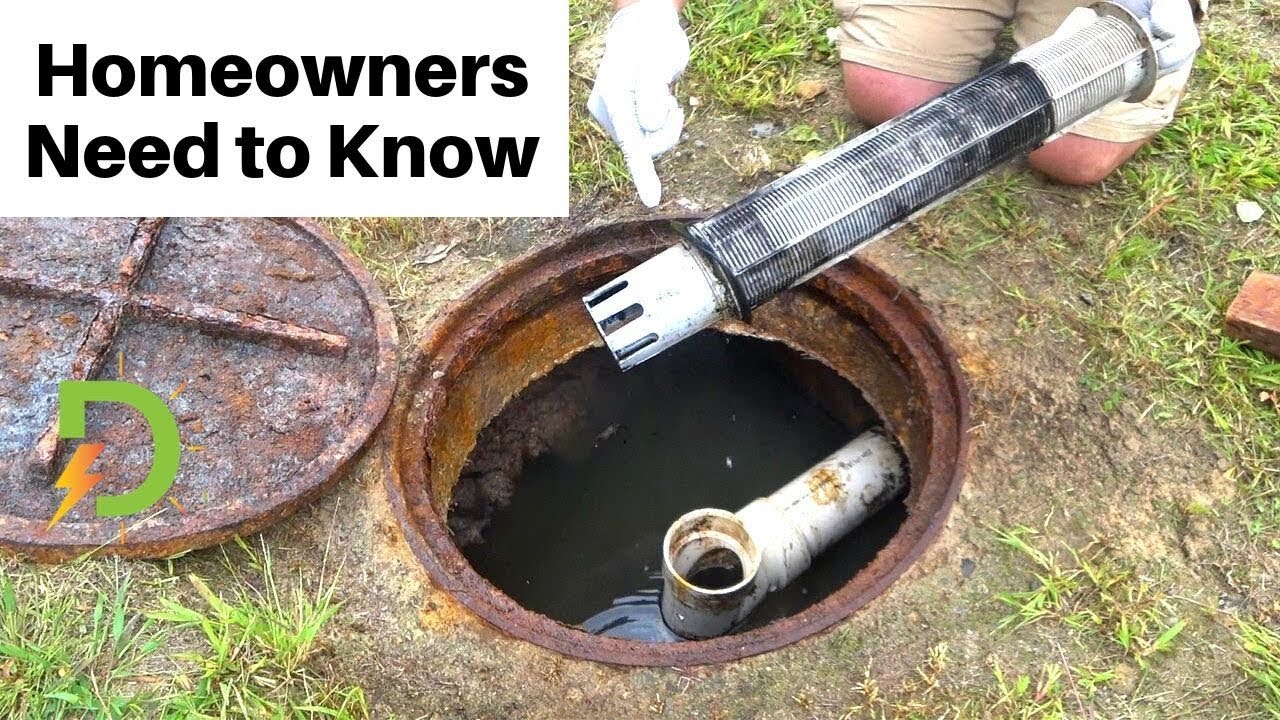In this article, you will learn about the importance of regular septic tank cleaning and the guidelines for proper maintenance. Taking care of your septic tank is crucial to ensure it functions efficiently and to prevent costly repairs or damage to your property. By understanding how often to clean your septic tank and following the proper maintenance guidelines, you can avoid potential problems and maintain a healthy and well-functioning septic system.
Regular septic tank cleaning is essential to prevent the buildup of solid waste and sludge in your tank, which can lead to clogs, blockages, and system failures. The frequency of cleaning may vary depending on factors such as the size of your household, the size of your septic tank, and the amount of wastewater generated. Generally, it is recommended to have your septic tank inspected and pumped every three to five years. However, if you have a larger household or a smaller tank, more frequent cleaning may be necessary. Remember, proper maintenance, such as avoiding the flushing of non-biodegradable items and using septic-safe products, is also crucial in prolonging the lifespan of your septic system and ensuring its optimal performance. By following these guidelines, you can ensure your septic tank remains in good condition and avoid any unwanted issues down the line.
What is a septic tank?
Definition of a septic tank
A septic tank is an underground wastewater treatment system that is commonly used in rural or residential areas without access to a centralized sewage system. It consists of a large container made of concrete, fiberglass, or other materials, which collects and treats the wastewater from your household.
How does a septic tank work?
When wastewater enters the septic tank through the plumbing system, it undergoes a natural separation process. The solid waste settles at the bottom of the tank, forming sludge, while the lighter materials such as grease and oils float to the top, creating a layer of scum. The liquid portion of the wastewater, known as effluent, is released into the drain field where it is further treated before being absorbed into the ground.
Why is septic tank cleaning important?
Prevention of clogs and backups
Regular septic tank cleaning is essential to prevent clogs and backups in your plumbing system. Over time, the solid waste and scum layer within the tank will accumulate and can block the outlet pipe or even enter the drain field. This can lead to sewage backups in your home, causing inconvenience and potential health hazards.
Avoiding foul odors
One of the most noticeable signs of a neglected septic tank is the presence of foul odors. When the tank is not regularly cleaned, the buildup of sludge and scum releases noxious gases, which can seep into your home or property. These odors can be unpleasant and even pose risks to your health.
Protection of groundwater and environment
Proper septic tank maintenance and cleaning help protect the groundwater and the environment. When a septic tank is not regularly cleaned, it can become overwhelmed with waste, leading to leakage or overflow. This can contaminate the groundwater, rivers, and streams, causing harm to aquatic life and potentially affecting the quality of drinking water.
Factors determining septic tank cleaning frequency
Household size
The number of people residing in your home is a significant factor in determining how often you should clean your septic tank. The more people using the system, the more wastewater and solids are produced, requiring more frequent cleaning.
Water usage
The amount of water your household consumes also affects the frequency of septic tank cleaning. Water usage includes not only showers, baths, and toilets but also dishwashing, laundry, and other activities that involve water. The more water used, the higher the load on your septic system, necessitating more frequent cleaning.
Septic tank size
The size of your septic tank plays a vital role in determining the cleaning frequency. Smaller tanks have less capacity to contain and process wastewater, resulting in more frequent cleanings. Larger tanks can hold more waste before reaching their capacity, requiring less frequent cleaning.
Type of waste disposed
The type of waste disposed into the septic tank can impact the cleaning frequency. Certain substances, such as chemicals, oils, food scraps, and non-biodegradable items, can interfere with the natural decomposition process and contribute to the accumulation of solids. It is crucial to avoid flushing or disposing of these materials to maintain a healthy septic system.
General guidelines for septic tank cleaning
Regular inspection and pumping
Regular inspection of your septic tank is essential to identify any issues early on. A professional septic tank service provider can inspect the tank, measure the sludge and scum levels, and determine if it needs pumping. Generally, septic tanks should be pumped every 3 to 5 years, depending on the factors mentioned earlier.
Recommended frequency for pumping
As a rule of thumb, the average household of four people with a 1,000-gallon septic tank should have it pumped every 3 to 5 years. However, it is crucial to consider other factors such as water usage, waste disposal, and the professional’s recommendations when determining the precise frequency for cleaning.
Signs indicating the need for cleaning
There are several signs that indicate your septic tank needs cleaning. These signs include slow drains, gurgling sounds in the plumbing, foul odors near the tank or drain field, sewage backups, and more frequent maintenance issues with your plumbing system. If you notice any of these signs, it is best to contact a professional septic tank service provider for an inspection and cleaning.

Septic tank maintenance tips
Avoid flushing non-biodegradable items
To maintain a healthy septic tank, it is essential to avoid flushing or disposing of non-biodegradable items. These include paper towels, diapers, feminine hygiene products, cigarette butts, plastics, and other materials that do not break down naturally. Flushing these items can lead to blockages and damage to your septic system.
Proper use of chemicals
Using excessive amounts of household chemicals such as bleach, drain cleaners, or antibacterial soaps can disrupt the natural balance of bacteria in your septic tank. These chemicals can kill the beneficial bacteria responsible for breaking down waste. It is advisable to use these products sparingly and opt for septic-safe alternatives whenever possible.
Conserving water
Water conservation is not only beneficial for the environment but also helps maintain the health of your septic system. Avoiding excessive water usage can prevent overloading the tank and prolong the time between cleanings. Simple measures such as fixing leaky faucets, using water-efficient appliances, and spreading out laundry and dishwashing loads can make a significant difference.
Proper landscaping around the septic system
Proper landscaping around your septic system is crucial to avoid potential damage. Avoid planting trees or shrubs with aggressive root systems near the tank or drain field, as the roots can infiltrate the septic tank and cause blockages. It is best to consult with a professional landscaper to ensure the proper placement of plants and other structures.
Professional septic tank cleaning services
Benefits of professional cleaning
Hiring a professional septic tank cleaning service offers several benefits. These professionals are trained and experienced in inspecting, pumping, and maintaining septic tanks. They have the necessary equipment to safely and efficiently clean your tank, ensuring all waste and build-up are removed properly. Professional cleaning helps extend the lifespan of your septic system and reduces the risk of costly repairs or replacements.
Choosing the right septic tank cleaning company
When selecting a septic tank cleaning company, consider their reputation, experience, and certifications. It is essential to choose a company that is licensed and insured to guarantee the quality of their work and protect yourself from any liability. Reading reviews and getting recommendations from trusted sources can help you find a reputable and reliable service provider.
What to expect during the cleaning process
During the septic tank cleaning process, the professional service provider will inspect the tank for any signs of damage or issues. They will then use a specialized truck-mounted vacuum to remove the sludge and scum from the tank. Once the cleaning is complete, they may conduct a final inspection and provide any recommendations for maintenance or repairs.
Costs associated with professional cleaning
The cost of professional septic tank cleaning can vary depending on factors such as the size of the tank, location, accessibility, and the amount of waste to be removed. It is advisable to obtain quotes from multiple service providers and compare their offerings. Remember that choosing the cheapest option may not always result in the best service, so consider the reputation and experience of the company as well.

DIY septic tank cleaning
Safety precautions
DIY septic tank cleaning can be hazardous, so it is crucial to follow proper safety precautions. Before attempting any cleaning, make sure to turn off the electrical supply to the tank, wear protective clothing and gear such as gloves and goggles, and use caution when handling any equipment or tools. If you are unsure or uncomfortable, it is best to leave the cleaning to the professionals.
Tools and equipment needed
To perform a DIY septic tank cleaning, you will need a septic tank cleaning hose, a long-handled brush or scraper, and a vacuum or pump to remove the waste. It is recommended to use equipment specifically designed for septic tank cleaning to ensure effectiveness and avoid damage to the tank.
Step-by-step guide to DIY cleaning
- Start by locating the septic tank access point, which is usually a manhole cover or a small opening in the ground.
- Open the access point and carefully inspect the tank for any signs of damage or issues. If you notice any, it may be best to consult a professional.
- Using the hose and brush/scrapper, carefully remove the solid waste and scum from the tank. Take your time and be thorough in cleaning all areas.
- Once the cleaning is complete, use the vacuum or pump to remove the waste from the tank. Be sure to dispose of the waste properly according to your local regulations.
- After cleaning, replace the access point cover securely, ensuring it is airtight to prevent any odors or debris from escaping.
Disposal of waste materials
Proper disposal of septic tank waste is essential to protect the environment and comply with local regulations. The waste should be taken to a designated facility that handles septic waste or disposed of through a wastewater treatment plant. It is crucial to follow all local regulations and guidelines for the disposal of septic waste to avoid any penalties or harm to the environment.
Common misconceptions about septic tank cleaning
Frequency of cleaning
One common misconception is that septic tanks only need to be cleaned when problems arise. Regular cleaning is essential for maintaining a healthy septic system, even if it seems to be functioning correctly. Ignoring regular cleaning can lead to costly repairs and potential health hazards.
Use of additives
Some people believe that using additives, such as septic tank cleaners or bacteria supplements, can eliminate the need for regular cleaning. While these products can enhance the performance of your septic system, they do not replace the need for proper cleaning and maintenance. Additives should be used as a supplement to regular cleaning, not as a substitute.
Septic tank lifespan
Another misconception is that septic tanks are designed to last indefinitely without maintenance. Septic tanks have a lifespan of around 20 to 40 years, depending on factors such as usage, maintenance, and materials. Regular cleaning and proper maintenance can help extend the lifespan of your septic tank and avoid premature failure.

Consequences of neglecting septic tank cleaning
Root intrusion
When septic tanks are not regularly cleaned, tree roots can infiltrate the tank through cracks or joints, causing blockages and damages. As the roots grow, they can disrupt the flow of wastewater, leading to backups and potential system failures. Regular cleaning can help detect and prevent root intrusion issues.
Septic tank failure
Neglecting septic tank cleaning can ultimately lead to system failure. When the tank reaches its capacity or becomes overwhelmed with waste, it can no longer effectively treat the wastewater. This can result in sewage backups, foul odors, and potential environmental contamination that may require expensive repairs or replacement.
Expensive repairs
Repairing a neglected or failed septic system can be a costly endeavor. The repairs may involve locating and fixing damaged pipes, replacing the tank, or even installing a completely new septic system. Regular cleaning and maintenance can help identify and address minor issues before they escalate into major and expensive repairs.
Health risks
A neglected septic system poses health risks to you, your family, and the environment. Backup sewage and leaking waste can expose you to harmful bacteria, viruses, and parasites. Additionally, the contamination of groundwater and nearby water bodies can affect the health and safety of the community and ecosystem.
Conclusion
Regular septic tank cleaning and maintenance are crucial for the proper functioning and longevity of your septic system. By understanding the factors that determine cleaning frequency and following the guidelines provided, you can ensure a healthy and efficient septic system. Remember to consult with professionals, prioritize safety, and adhere to local regulations for the proper disposal of waste materials. Proper maintenance will not only prevent costly repairs but also protect your health and the environment.


